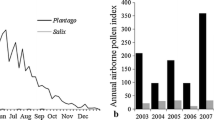Abstract
Hydroperoxides of d-limonene were shown to be potent contact allergens when studied in guinea-pigs. Limonene-2-hydroperoxide (2-hydroperoxy-p-mentha-6,8-diene, a mixture of trans and cis isomers) was synthesized for the first time. The ratio between the trans and cis forms was 3∶1. These two hydroperoxides were identified as the major hydroperoxides in autoxidized d-limonene. In photooxidized d-limonene, they constituted a minor part of the hydroperoxide fraction. Hydroperoxides may bind to proteins of the skin to make antigens either via a radical mechanism or after reactions to give epoxides. The cross-reactivity between the epoxide limonene-1,2-oxide, a potent contact allergen, and the hydroperoxides was therefore studied. No significant pattern of cross-reactivity was found. Further studies to identify and test the allergenicity of single hydroperoxides are needed to elucidate the mechanism of the allergenicity.
Similar content being viewed by others
References
Basketter DA, Allenby CF (1991) Studies of the quenching phenomenon in delayed contact hypersensitivity reactions. Contact Dermatitis 25: 160–171
Boman A, Karlberg A-T, Wahlberg JE (1988) Experiences with Freund's complete adjuvant test (FCAT), when screening for contact allergens in colophony. Contact Dermatitis 18: 25–29
Clark BC Jr, Jones BB, Iacobucci GA (1981) Characterization of the hydroperoxides derived from singlet oxygen oxidation of (+)-limonene. Tetrahedron 37: 405–409
Collington EW, Meyers AI (1971) A facile and specific conversion of allylic alcohols to allylic chlorides without rearrangement. J Org Chem 36: 3044–3045
Cookson PG, Davies AG, Brian PR (1976) A convenient and general preparation of alkyl hydroperoxides and dialkyl peroxides. J Chem Soc Chem Commun: 1022–1023
Dykstra S, Mosher HS (1957) Organic hydroperoxides VI. Allyl hydroperoxide. J Am Chem Soc 79: 3474–3475
Frimer AA (1977) A convenient synthesis of allylic hydroperoxides. J Org Chem 42: 3194–3196
Gildemeister E, Hoffmann FR (1960) Die Ätherischen öle. Band 3A. Akademie-Verlag: Berlin, pp 45–75
Grayson DH (1990) Monoterpenoids. Natural Product Reports 7: 327–347
Grimm W, Gries H (1967) Untersuchungen über die Terpentinöl-Allergie. Berufsdermatosen 15: 253–269
Hellerström S, Thyresson N, Blohm S-G, Widmark G (1955) On the nature of the eczematogenic component of oxidized δ 3-carene. J Invest Dermatol 24: 217–224
Hellerström S, Thyresson N, Widmark G (1957) Chemical aspects on turpentine eczema. Dermatologica 115: 277–286
Hoffman J (1957) Preparation of some substituted allyl hydroperoxides from bromides. J Org Chem 22: 1747–1749
Karlberg A-T (1988) Contact allergy to colophony. Chemical identification of allergens, sensitization experiments and clinical experiences. Acta Derm Venereol [Suppl] (Stockh) 139: 1–43
Karlberg A-T, Bohlinder K, Boman A, Hacksell U, Hermansson J, Jacobsson S, Nilsson JLG (1988) Identification of 15-hydroperoxyabietic acid as a contact allergen in Portuguese colophony. J Pharm Pharmacol 40: 42–47
Karlberg A-T, Boman A, Melin B (1991) Animal experiments on the allergenicity of d-limonene — the citrus solvent. Ann Occup Hyg 35: 419–426
Karlberg A-T, Magnusson K, Nilsson U (1992) Air oxidation of d-limonene (the citrus solvent) creates potent allergens. Contact Dermatitis 26: 332–340
Klecak G (1985) The Freund's complete adjuvant test and the open epicutaneous test. In: Andersen KE, Maibach HI (eds) Contact allergy predictive tests in guinea pigs, 1st edn. Karger, Basel London New York, pp 152–171
Magnusson B, Kligman AM (1970) Allergic contact dermatitis in the guinea pig. Identifications of contact allergens. CC Thomas: Springfield, pp 120–123
McLelland J, Shuster S (1990) Contact dermatitis with negative patch tests: the additive effect of allergens in combination. Br J Dermatol 22: 623–630
Okabe H, Yasuko O, Takayama K, Nagai T (1990) Percutaneous absorption enhancing effect and skin irritation of monocyclic monoterpenes. Drug Design Delivery 6: 229–238
Opdyke DLJ (1975) Monographs of fragrance raw materials. Food Cosmet Toxicol [Suppl]. (Special Issue II) 13: 825–826
Opdyke DLJ (1976) Inhibition of sensitization reactions induced by certain aldehydes. Food Cosmet Toxicol 14: 197–198
PirilÄ V, Siltanen E (1958) On the chemical nature of the eczematogenic agent in oil of turpentine III. Dermatologica 117: 1–8
Schenck GO, Neumüller OA, Olhoff G, Schroeter S (1965) Zur Autoxydation des (+)-Limonens. Liebig Ann Chem 687: 26–39
Schieberle P, Maier W, Firl J, Grosch W (1987) HRGC separation of hydroperoxides formed during the photosensitized oxidation of (R)-(+)-limonene. J High Resolut Chromatogr Commun 10: 588–593
Widmark G (1957) Autoxidation of (+)-limonene. Arkiv Kemi 11: 211–218
Williams AC, Barry BW (1991) The enhancement index concept applied to terpene penetration enhancers for human skin and model lipophilic (oestradiol) and hydrophilic (5-fluorouracil) drugs. Int J Pharm 74: 157–168
Author information
Authors and Affiliations
Rights and permissions
About this article
Cite this article
Karlberg, A.T., Shao, L.P., Nilsson, U. et al. Hydroperoxides in oxidized d-limonene identified as potent contact allergens. Arch Dermatol Res 286, 97–103 (1994). https://doi.org/10.1007/BF00370734
Received:
Issue Date:
DOI: https://doi.org/10.1007/BF00370734




